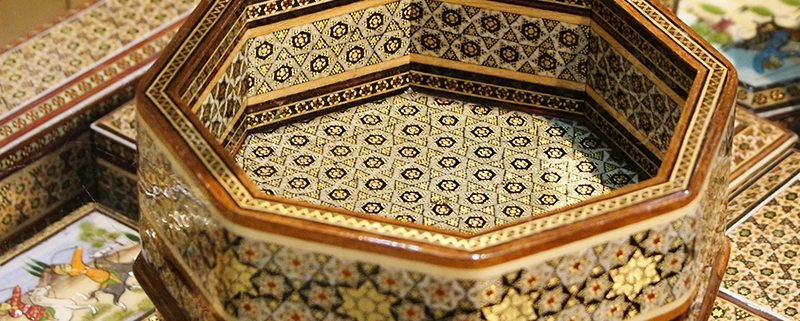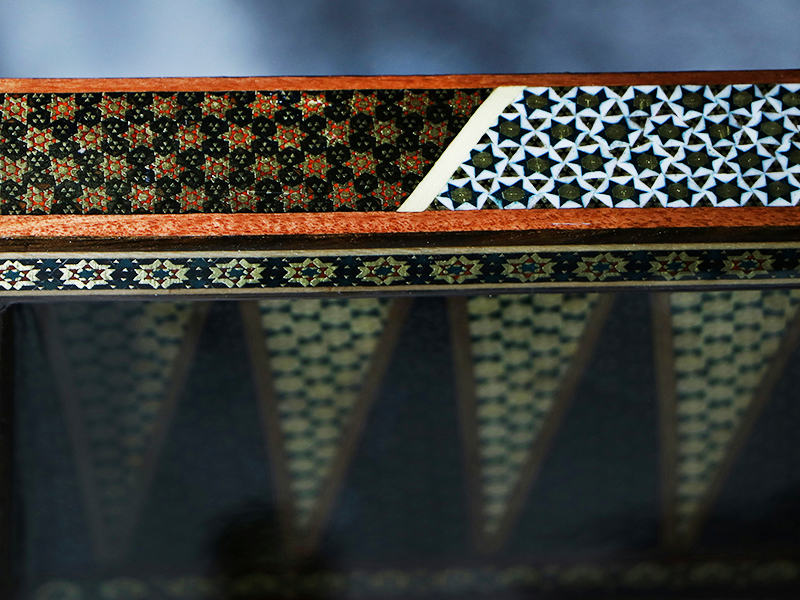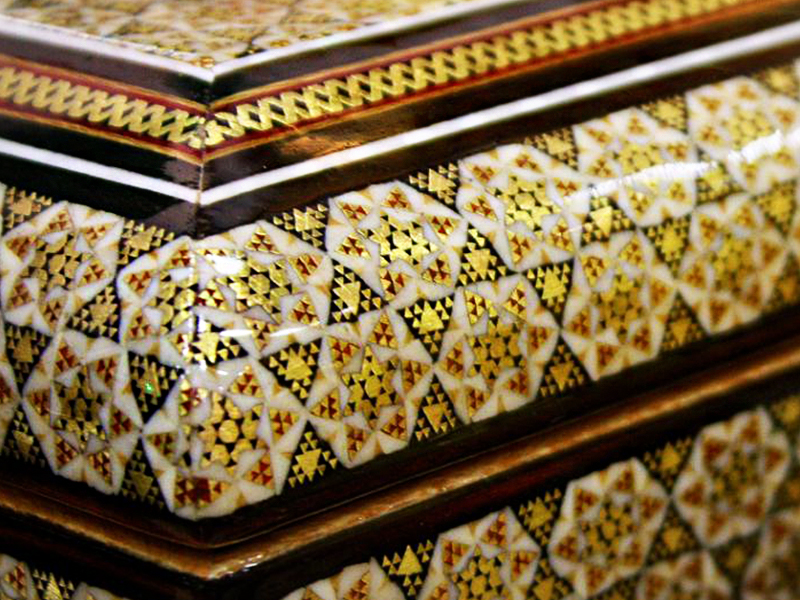Khatam Kari (Marquetry): Meaning, History, Technique
Khatam Kari (Marquetry) is a noble art that is used to decorate surfaces and is characterized by the placement of small and colorful polygons that are carefully arranged together. The goal is to create mosaic-like or triangle-like geometric patterns that result in a harmonious and complex design.
Beyond the decoration of wooden doors and windows, Khatam-Kari becomes especially important in sacred and historical places, often gracing items like chocolate boxes, nut bowls, sweet trays, jewelry boxes, Quran covers, penholders, clocks, and mirrors, adding a touch of elegance to everyday objects. Objects adorned with fine Khatam inlay, whether metal or wood, hold great material value and are considered precious artifacts.
In this article, we will delve into the history of Iranian khatam kari, explore the techniques for recognizing fine Khatam kari artworks, and familiarize ourselves with its various types and applications.
Khatam Kari History
The exact origin of Khatam Kari is somewhat unknown, and there are no definite records of its origin. But the oldest existing examples of this art date back more than a century and are found in the city of Shiraz, which especially adorns the minbar of Atigh Mosque. Shiraz is known as the birthplace of Khatam-Kari, although this art flourished in Isfahan during the Safavid era and eventually became synonymous with the city.
The peak of Khatam Kari development happened in the Safavid period. Artists from different cities were invited to the capital city, Isfahan, where they not only engaged in inlay work but also engaged in woodcarving, tile work, and knot work and participated in the construction of government buildings, palaces, and holy places.
However, in the Qajar era, like many other arts, Khatam Kari was neglected, and its prestige and importance decreased. Masters and craftsmen of this industry suffered hardships during this period.
Among the famous masters of this art in Shiraz and Iran, we can mention Abdul Khalegh Gholriz Khatami, known as the father of Khatam of Iran, the late Abdul Ali Gholriz Khatami, and Ahmad Rouhani, each of whom made a significant contribution to this field of art.
In addition, in the early Islamic centuries, there was a form of surface decoration or simple Khatam called “Khatam-e Moraba” in Iran. In this style, instead of triangles, different shapes of square, rectangle, parallelogram, and rhombus were used, which continues even centuries after the emergence of the modern form of Khatam.
What Is the Origin of Khatam?
The exact origin of Khatam is not exactly documented. But some of the oldest examples of Khatam Kari, dating back more than a century, can be found in Shiraz, Iran.
It is believed that Shiraz is the birthplace of Khatam Kari, although, during the Safavid era this art flourished in Isfahan. During this period, artisans from different regions were invited to Isfahan to participate in the decoration of government buildings, palaces, and holy places.
What Is Khatam in Persian?
Khatamkari, as mentioned in Persian encyclopedias, is the art of decorating surfaces in a mosaic-like manner using small triangles. The motifs in Khatam are continuous, geometric, and regular, which are obtained by arranging small triangles next to each other.
These triangles are made of different materials, such as wood, metal, and bone. The smaller and more complex the triangles are, the higher the quality of the inlay. In Khatam designs, at least three triangles are used to form the smallest geometric unit, while up to four hundred triangles may be used for larger designs.
What Is the Khatam Kari Technique?
The Khatam-Kari technique is a traditional Iranian art that involves decorating surfaces with intricate geometric patterns using small triangles made of materials such as wood, metal, and bone. Craftsmen have carefully arranged these triangles next to each other to create harmonious and orderly designs.
The quality of the seal depends on the delicacy and precision of the triangles used. Each design uses at least three triangles to form the smallest geometric unit, while larger designs may contain up to four hundred triangles. This technique requires skill, patience, and attention to detail, resulting in beautifully decorated objects enriched with cultural heritage.
What Is the Meaning of Khatam Kari?
In the dictionary of Dehkhoda, Khatam Kari is defined as:
“Khatam Kari” (compound noun) embedding bone in wood with carving and decoration.
Khatam-Sazi refers to Khatam-Bandi and Khatam-Sazi: Assyrians were skilled in the work of various industries, such as goldsmithing and Khatam-Kari. According to this definition, Khatam-Kari involves the process of embedding bone in wood, often with intricate carvings and decorations, showcasing the skill and craftsmanship of the artisans.
What Is Persian Khatamkari?
Persian Khatamkari is a combination of regular polygons with different numbers of sides designed by artisans using different materials in specific colors. These polygons can have five, six, seven, eight, or ten sides and can be arranged on a surface to create geometric, mosaic-like, or triangular patterns.
The key aspect is the regularity of these polygons and their regular arrangement next to each other. The art of Persian Khatamkari consists of two main components: Khatam-Sazi, which includes the initial stages of creating polygons, and Khatam-Kari, which includes the stages of assembling, cutting, and finishing the work of art.
Khatam Kari Prices
Khatam-Kari prices vary depending on factors such as the size, design complexity, materials used, and the craftsmanship involved. Smaller, simpler pieces may be more affordable, while larger, more elaborate works of art made with delicate materials and intricate designs can have higher prices.
In addition, the reputation and skill level of the craftsman or workshop can also affect the cost. In general, the price of Khatam Kari varies from medium to high, which reflects the value placed on this traditional Iranian art and the careful attention to detail required in its creation.
Khatam Kari Box
A Khatam-Kari box is a stylish and beautiful wooden box that is used to store jewelry, money, and other valuables or as a gift. It is a precious and valuable gift item that is appreciated for its intricate Khatam-Kari decoration along with its well-made box and strong and graceful painting.
The beauty of the fine Khatam inlay on the box, along with the exquisite craftsmanship and beautiful design, help to the popularity of these boxes as admired items or gifts.
Khatam Kari Paintings
Khatam-Kari paintings are fine artworks that have complex geometric patterns created with the traditional Persian Khatam technique. These paintings often include a Khatam frame, adding elegance and cultural significance to the artwork. The frame surrounds the central painting scene, enhances its beauty, and provides a beautiful border.
Artists skillfully combine vibrant colors and precise geometric shapes to produce stunning compositions that capture the viewer’s attention. Khatamkari paintings are not only admired for their aesthetic appeal but also for their cultural heritage and craftsmanship in their creation.
Final Word
In conclusion, Khatam Kari is an amazing Iranian art known for its intricate geometric patterns and exquisite craftsmanship. From decorative boxes to stunning paintings adorned with Khatam frames, this traditional technique adds beauty and cultural richness to a variety of objects. Khatam Kari, this Persian handicraft, whether as a souvenir or a gift, is a reminder of Iran’s artistic heritage and should be on the list of must-buy items for travelers traveling to this country. Khatam Kari, with its beauty and cultural importance, continues to fascinate and inspire admirers all over the world.
Are you planning to travel to Iran and looking for an Iran travel agency? Check out our Iran tours.









Leave a Reply
Want to join the discussion?Feel free to contribute!